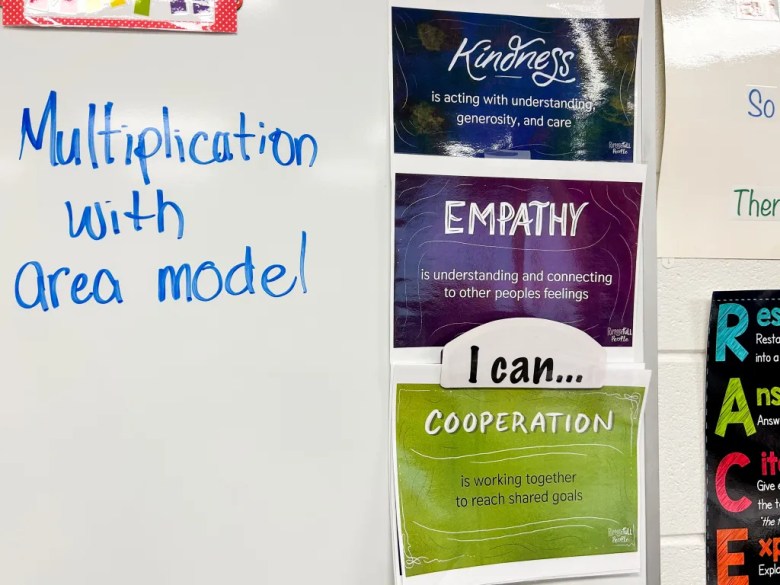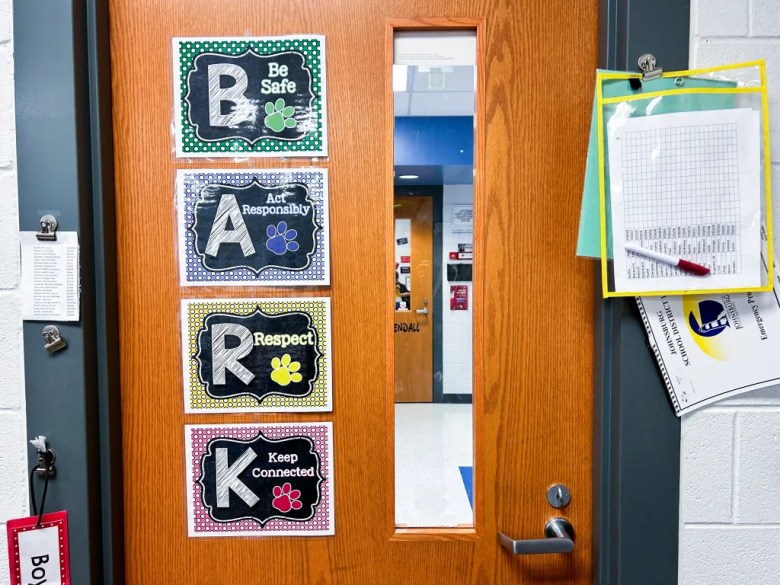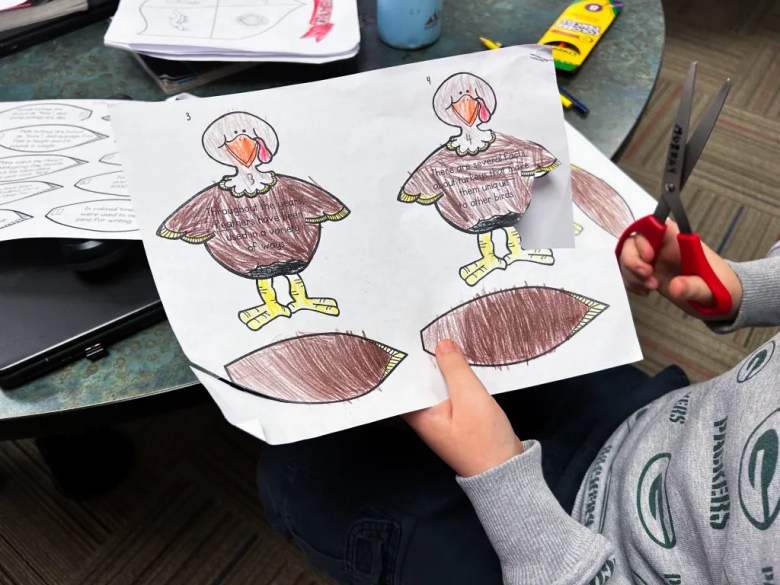JOHNSBURG, Ill. — A group of fifth grade boys trailed into the conference room in the front office of Johnsburg Elementary School and sat at the table, their feet dangling from the chairs.

“It was brought to my attention yesterday that there was an incident at football,” Principal Bridget Belcastro said to the group.
The students tried to explain: One boy pushed a kid, another jumped on the ball, and yet another jumped on the boy on the ball. It depended on who you asked.
“I tripped — if I did jump on him, I didn’t mean to,” one student said. “Then I got up and turned around and these two were going at each other.”
Belcastro, listening closely, had the unenviable job of making sense of the accounts and deciding on consequences.
In elementary schools across the country, an incident as common as a playground fracas over a football could result in kids being suspended.
A Hechinger analysis of school discipline data from 20 states found widespread use of suspensions for students of all ages for ill-defined, subjective categories of misbehavior, such as disorderly conduct, defiance and insubordination. From 2017 to 2022, state reports cited these categories as a reason for suspension or expulsion more than 2.8 million times.

In many cases, young students were removed from their classes for behavior that is common for kids their age, according to additional discipline records from half a dozen school districts obtained through public records requests.
In Montana, students in K-5 made up almost 4,000 suspensions for disorderly conduct. In New Mexico, it was nearly 2,700.
Elementary school students are often punished for conduct that experts say is developmentally typical of children who are still learning how to behave and appropriately express themselves in school. Even severe behaviors, like kicking or punching peers and teachers, can be a function of young children still figuring out how to regulate their emotions.
In many other cases, the behavior does not appear serious. In Washington, a kindergarten student was suspended from school for two days for pulling his pants down at recess. A second grader in Rhode Island was suspended when he got mad and ran out of the school building. In Maryland, a third grader was suspended because she yelled when she wasn’t allowed to have cookies, disrupting class.
At Johnsburg Elementary School, which serves about 350 third through fifth grade students on the northern outskirts of Chicago’s suburbs, administrators are trying to limit the use of suspensions. Student conferences, like the one after the fight during football, are just one piece of a much larger effort aimed at preventing and addressing misbehavior. In the end, the boys didn’t lose time in the classroom, but they were no longer allowed to play football at recess.
Belcastro’s decision not to suspend the boys was based on research that consistently shows suspending students makes it more difficult for them to succeed academically and more likely they will enter the criminal justice system as adults.
Suspension can be particularly damaging when doled out to younger students, said Iheoma Iruka, a professor of public policy at the University of North Carolina-Chapel Hill. Being kicked out of the classroom can fracture kids’ trust in their teachers and the institution early on. Those early impressions can stay with students and cause long-lasting harm, Iruka said, particularly to students for whom school is the most consistent part of their lives.
“Over time, it erodes children’s sense of safety. It erodes their relationship with teachers,” said Iruka, who is also the founding director of the Equity Research Action Coalition at UNC, a group that researches and develops policies to address bias in the classroom.

In part because of concerns like these, advocates and policymakers across the country often focus on the early grades when pushing for discipline reform. At least 17 states and D.C. have passed laws to limit the use of suspension and expulsion for younger children, typically students in pre-K through third or fifth grade. In Illinois, where Johnsburg Elementary School is located, schools are allowed to suspend young students, but legislators passed a law in 2015 that encourages using suspension as a last resort.
Child development experts say that, ideally, suspensions should be used only in extremely rare circumstances, especially in elementary school.
Suspended for…what?
Students miss hundreds of thousands of school days each year for subjective infractions like defiance and disorderly conduct, a Hechinger investigation revealed.
Misbehavior at any age is often a symptom of deeper issues, experts say, but young children, especially, struggle to identify those issues and communicate them effectively. Students in the early grades are also still trying to figure out how to function in a school environment.
“We can hold older students accountable to know the rules of behavior in their schools,” said Maurice Elias, a professor of psychology who researches social emotional learning at Rutgers University. “We certainly can’t expect younger children to know all of those things and to anticipate the consequences of all their actions.”
And young students need to be specifically taught how to manage their emotions, added Sara Rimm-Kaufman, a professor of education at the University of Virginia.
“Helping kids understand what’s OK at home might not be OK at school, or making kids feel appreciated, respected, understood — that’s a really important issue and it keeps kids engaged,” she said.
Teachers at Johnsburg Elementary are trying to do just that.
The school adopted a new program this year called Character Strong, which is aimed at helping students with coping, emotional regulation, self-management and relationships. A few weeks into the school year, teachers filled out a screener to identify students struggling in those areas.

On a Thursday morning in November, four third graders left class to meet with social worker Dawn Mendralla. Twinkling lights lined the ceiling of her office; a small flip book depicting various emotions was opened to a page with a purple creature gritting its teeth and holding up its fists in frustration. A poster on the cabinet said: All feelings are welcome here.
“Regulation means we’re controlling ourselves, we’re controlling our behaviors, we’re controlling our emotions,” Mendralla said to the students. “Do we have trouble sometimes controlling our behaviors in class? Sometimes we have the urge to talk to our neighbor, or we have the urge to look out the window, or to not pay attention or to fidget with something?”
Once a week, the identified students attend a group session with Mendralla focused on improving those skills. Children who need more help also briefly check in with Mendralla, individually, every day. Students who misbehave, like the group of boys who got into a fight at recess, are also sent to Belcastro’s office.
Like other schools throughout the country, Johnsburg Elementary has been dealing with the ongoing impact of the pandemic on children’s behavior.
“There’s an increase in emotional outbursts, frustration, and they don’t know how to manage their emotions effectively,” Belcastro said. “Secondly, would be social interaction changes, because they weren’t around other kids and other people for so long, they didn’t have that and now they’ve forgotten how or never learned how to make friends.”
During the 2022-23 school year, Johnsburg Elementary had 687 referrals, or disciplinary write-ups, involving a student misbehaving, up from 222 referrals in 2021-22 and 276 referrals in 2018-19.
Even with the rise in behavior challenges, the school has tried to limit student suspensions; Through February of this school year, only three students had been given an in-school suspension and one had been sent home.
Elsewhere, though, the post-pandemic rise in misbehavior has caused some states to backtrack on policies limiting exclusionary discipline and instead made it easier for schools to kick students out of class.
In Nevada last year, legislators lowered the age at which students can be suspended or expelled from 11 to 6 and made it easier for schools to suspend or expel students.
In 2023, Kentucky lawmakers gave principals the ability to permanently kick students out of school if they believe the student will “chronically disrupt the education process for other students” and if they have been removed from class three times for being disruptive.
“There’s just been more and more discipline problems across the nation, and definitely across the state. We’ve just gotta get things under control,” said Rep. Steve Rawlings, who was among the legislation’s sponsors. “We have to prioritize the safety of teachers in the classroom and fellow students so that the focus can be on academics and not be distracted by issues of discipline.”
Elias and other experts say suspension should act more as a rare safety measure in extreme cases, rather than a disciplinary measure.

In the discipline records The Hechinger Report obtained, some school districts reported suspending young children under disruptive conduct for punching peers or throwing items at teachers.
In such cases, suspension may make sense, experts say, while allowing educators time to develop a longer-term response to the misconduct. But schools should not expect that removing kids from class will magically improve their behavior.
“When a child comes back into a classroom after a situation like this, it’s often that there’s just going to be a continuation of what was happening before, unless the child is brought back into the community in a way that changes the direction and nature of the relationships between the child and the people around them,” Rimm-Kaufman said
That’s something Belcastro has argued as well. Occasionally, there are tensions with parents who want to see other students punished when their own child has been harmed in some way. Belcastro doesn’t’t think that’s an effective approach.
“Punishments do not change behavior. No kid at this age level considers what the potential consequences might be before they do an action,” Belcastro recalled telling one parent who was upset about a student at the school. “So it really serves no purpose, it’s not helpful. But instead, working to prevent the behavior is what we need to do, so it doesn’t’t happen again.”
In Mendralla’s room, a small group of fourth grade boys showed up for a group session one day in November. The goal of this weekly session is for students to learn how to better regulate their emotions.
“What happens when we keep things all to ourselves, things build up, and we keep things bottled up inside us?” Mendralla asked.
“Then you explode,” a student said. “With emotions.”
Mendralla asked the students to think of rules they would like to have for these group sessions. A couple of students threw out suggestions: no running around the room, no interrupting, no blaming others, nobody is better than anybody else.
Another fourth grader raised his hand.
“If there’s another person making fun of another person because of the way they look and act, don’t join in,” he said. “We don’t know what they’re going through.”
This story about misbehavior in young children was produced by The Hechinger Report, a nonprofit, independent news organization focused on inequality and innovation in education. Sign up for the Hechinger newsletter.



